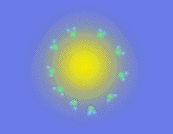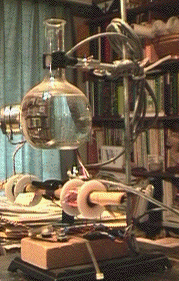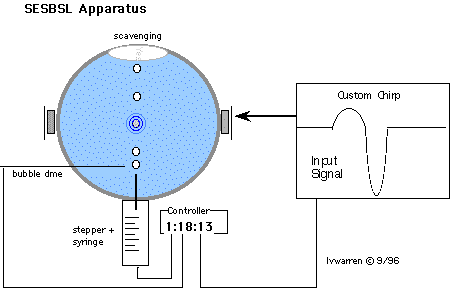

Abstract
Two kinds of closed loop feedback control are proposed for modifying the
acoustic excitation that gives rise to the phenomenon of sonoluminescence
(SL). The first called BARC, for "Bubble Active Rise Control",
relates to the release and tracking of bubbles of larger size than those
that are naturally captured in the nodal field of an acoustic cavity. The
second called BAKE for "Bubble Active Compression Evaluation",
relates to tracking the collapse of the bubble and modifying subsequent
waveforms to obtain higher compression ratios via closed loop feedback.
Also creating prefabricated gels of specific bubble sizes altering the exciter
frequency is proposed.
Introduction
Several methods have been developed for introducing a bubble into the
center of a SL test cell, typically a 100 ml round neck flask. Originally
a glass syringe was used, subsequently a small heater coil was utilized.
Bubble introduction is described in the February 1995 Scientific American
article by Seth Putterman and in the companion Amateur Scientist article
by Robert Hiller and Bradley Barber. Elsewhere
and in our own experiments this has been characterized as follows; When
acoustic pressure forces exceed buoyant forces the bubble is drawn into
the active region, usually with a "swirling" or chaotic motion
prior to the bubble, "locking down" or fixating in the focus of
the radiating transducers. An artifact of this process is that only certain
bubble sizes are "eligible" for fixation. It is conceivable that
we might want to introduce bubbles whose buoyant forces dominate into the
active region. I propose that we don't bother trying to suspend such bubbles.
Let's face the fact that bigger bubbles want to float. Let them.

BARC: Bubble Active Rise Control
My alternative is to inject a larger than traditional bubble (size ~ 50
microns) at the bottom of the flask. It floats to the top. We track the
bubble. We know where that bubble started. We can predict and control where
it is going. We can steer it as it rises. Consider:

"Steering" implies the bubble guided on its vertical trajectory by an acoustic steering field. This steering field is not the sinusoidal excitation required for sonoluminescence. Consider Taylor Wang's globule levitation experiment. In his experiment, which was conducted aboard the space shuttle, the roles of the water and the fluid are reversed. An acoustic field was used to control the position of the globule. In a reversal of Want's experimnet, I want to exchange the roles of the fluid in a manner akin to considering the flow of "holes" versus the flow of particles in solid state electrodynamics. I call the act of steering this new, larger bubble cross section "Bubble Active Rise Control", or BARC for short. Continuing in our experimental scenario, when the bubble cross-section enters the center of the test cell, we move it with a steering field. We excite the bubble with a second signal. The purpose of this second signal is to induce sonoluminescence. Previous experiments have typically used a high intensity 27 kHz +/- 1 kHz sinusoid in a 100ml quartz test cell.
BAKE: Bubble Active Compression Evaluation
Another instrumentation suite, could monitor the size of the bubble. Based
on that, the exciting waveform would be modified to "crack the whip".
In a phone conversation in January I suggested this "crack the whip"
effect to Willie Moss and went on to recommned that we do this in solutions
of D20, T20 and aqueous Li-6+.
On March 29, 1996 he published a variant of this idea in paper on
a process he called "pressure spiking" in D20.
I choose to call this process "chirping", since the optimal waveform
may not be just an impulse function or "spike".
An Analogy
For an everyday macroscopic analogy, consider the act of shooting an arrow
using a compound archery bow with cam pulleys at each end. The force versus
string displacement is smoothly nonlinearized so that the "pull"
required is hard at first, and then softens or "breaks" at the
end so that the archer may hold their aim. This accelerates the arrow smoothly
at first but then more vigorously at the end in a continuous fashion.
I have suggested subjecting the SL bubble to the same accelerating force profile by using a nonsinusoidal waveform, in an active, closed loop feedback system, where the bubble state vector is measured, and the signal is modified in real time. In an actively instrumented and controlled system the rarefacting part of the waveform would be a sinusoid, but the compression phase would proceed with continuously increasing slope to the near singular "chirp". The best shape of this chirp could be iterated using a stored waveform table, it could be penned in and digitized, OR it could be based on the shape of a previously recorded event. I would like to investigate using cycloids for excitation instead of sinusoids, per the famous Bernoulli brothers brachisochrone problem. The phase between the measurement and the waveform could be a "knob" under user control to account for delays in the system.
Sample and Hold
This is not too difficult to do. Consider the process of sampling naturally
occurring waveforms on a digital music synthesizer. The process is: 1) Grab
a voice, 2) modify the voice using an appropriate mapping then, 3) play
the voice back, frequency and phase shifted. An analogous process could
work here, in a sequence of chirps that evolve or adapt over time based
on the brightness of the flash and the size of the bubble. So that
is the description "Bubble Active Kompression Evaluation (BAKE).
This could be combined with the documented pressure and temperature effects
that increase the photon output of each event.
Much higher sampling rates would be required for BAKE compared to bubble steering, however, the tracking rates for 27 kHz signals are still well within the confines of digital sound systems. We have been using the acoustic software, "Out of Phase" to generate waveforms for transmission to the test cell. If funding is available we would like to establish true feedback, Jimi Hendrix style.
Gel Test Cells
Finally, to solve the bubble steering problem, it would be appropriate to
create gels containing a single bubble, that could be introduced into an
appropriately modified test cell. Different frequencies and waveforms
could then be applied to the "bubble" without worrying about losing
it due to the presence of gravity or turbulence in the working fluid.
© 1996 L. Van Warren * All Rights Reserved *